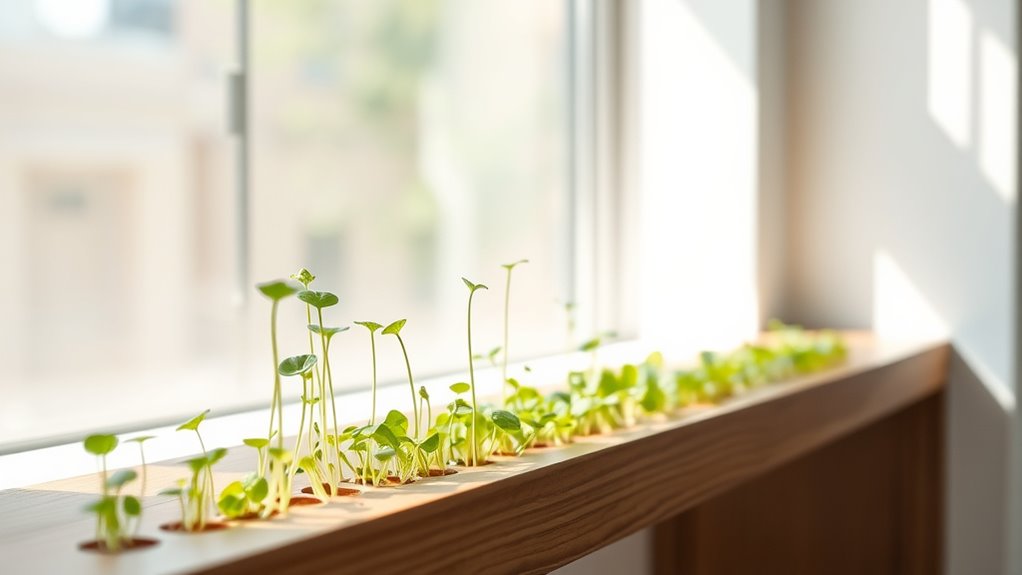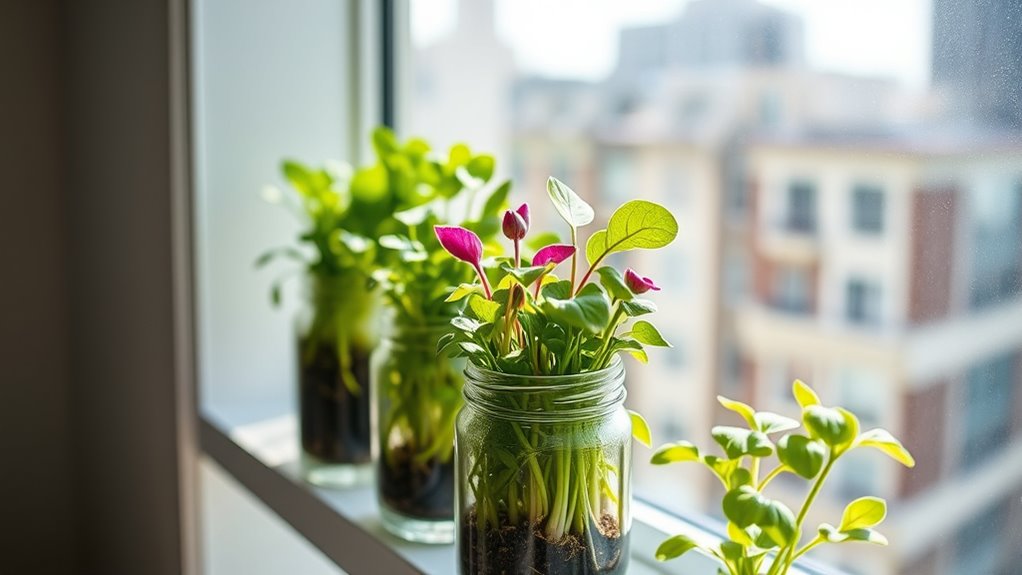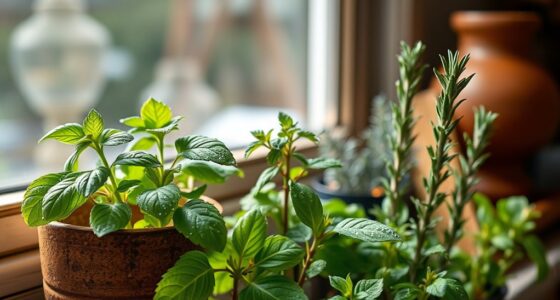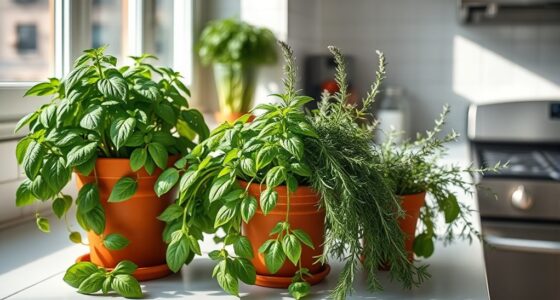Growing microgreens in the city lets you enjoy farm-to-table freshness right on your shelf or balcony. They thrive with minimal space, using natural sunlight or grow lights, and can be harvested in just a couple of weeks. Plus, you’re reducing your carbon footprint by cutting down on store-bought veggies and packaging waste. Curious to learn how to set up your urban farm and get the most out of your microgreens? Keep exploring for the full scoop.
Key Takeaways
- Microgreens offer a quick, space-efficient way to bring fresh, nutrient-rich produce directly to urban shelves and kitchens.
- They can be easily grown indoors on windowsills or shelves with minimal resources and natural or artificial light.
- Growing microgreens supports local food systems, reduces transportation emissions, and promotes sustainable city living.
- They enhance farm-to-table experiences by providing fresh greens for salads, garnishes, and meals right at home or in restaurants.
- Incorporating microgreens into urban settings encourages self-sufficiency and fosters community sharing of homegrown harvests.

Urban dwellers are discovering that growing microgreens is a simple and rewarding way to bring fresh, nutritious produce into city life. As more people seek ways to connect with their food and reduce their ecological footprint, microgreens have become a popular choice for urban farming. With limited space, you can turn a small balcony, windowsill, or even a countertop into a mini farm that provides a steady supply of vibrant greens. Not only does this practice support city sustainability by reducing reliance on store-bought vegetables, but it also encourages a more self-sufficient lifestyle within urban environments.
Microgreens thrive in city settings because they require minimal space and resources. By growing these tiny plants indoors or in small outdoor patches, you cut down on transportation emissions and packaging waste associated with traditional produce. This makes microgreens an eco-friendly addition to your urban farming efforts, aligning with city sustainability goals of lowering carbon footprints and promoting local food production. Plus, cultivating microgreens is quick; most varieties are ready to harvest within a couple of weeks, making it easy to fit into your busy schedule.
To start, all you need is a shallow tray, some soil or growing medium, and your choice of microgreen seeds—think radish, basil, or sunflower. You can set this up on a sunny windowsill or under grow lights if natural sunlight is limited. As the plants sprout, you’ll notice how quickly they develop, offering fresh greens that are packed with nutrients and flavor. Growing microgreens indoors also means you avoid pesticides and other chemicals often used in large-scale farming, ensuring your greens are pure and healthy.
One of the key benefits of incorporating microgreens into your urban farming routine is their versatility. Use them to enhance salads, sandwiches, smoothies, or as a garnish to elevate any meal. Not only do they add flavor and visual appeal, but they also provide a concentrated source of vitamins and antioxidants. Sharing your microgreen harvest can foster community connections, inspiring others to adopt sustainable practices in their own apartments or communal spaces.
In essence, microgreens serve as a bridge between urban farming and city sustainability. They demonstrate that even in limited spaces, you can make a positive environmental impact while enjoying fresh, nutritious food. By cultivating these tiny greens on your shelf, you participate in a movement toward more sustainable, localized food systems—proving that farming doesn’t have to happen in sprawling fields but can thrive right in your city home. Additionally, understanding the importance of contrast ratio in your lighting setup can significantly improve the growth and visual quality of your microgreens.
Frequently Asked Questions
How Long Do Microgreens Stay Fresh After Harvest?
After harvest, microgreens typically stay fresh for 5 to 7 days if stored properly. To maximize freshness, pay attention to harvest timing and pick them at the right stage. Store microgreens in a breathable container, like a paper towel-lined container, and keep them refrigerated. Use small portions at a time, and avoid excess moisture, which can cause spoilage. Proper storage tips help extend their vibrant flavor and crisp texture.
Can Microgreens Be Grown Indoors Without Sunlight?
You can definitely grow microgreens indoors without sunlight by using indoor lighting and suitable growth substrates. Instead of natural sunlight, you rely on grow lights like LED or fluorescent to provide the necessary spectrum for healthy growth. Choose growth substrates such as soil, coco coir, or hydroponic mats, and place your microgreens under the lights. With proper lighting and quality substrates, you’ll enjoy fresh microgreens year-round, regardless of sunlight outside.
Are There Any Health Risks Associated With Microgreens?
You might wonder if microgreens pose health risks. While they’re nutritious, you should be aware of pesticide concerns and contamination risks. If microgreens aren’t grown organically or properly handled, they could carry bacteria or chemicals. Always buy from trusted sources or grow them yourself under safe conditions. This way, you reduce potential health issues and enjoy the benefits of fresh, healthy microgreens without worry.
What Are the Best Microgreens for Beginners?
It’s no coincidence that beginners often find arugula, radish, and sunflower microgreens the easiest to start with. You can grow these varieties in simple hydroponic setups, making them accessible and low-maintenance. These microgreen varieties sprout quickly and are forgiving, helping you build confidence as you learn. Their distinct flavors also add a delightful touch to salads, encouraging you to explore more microgreen varieties over time.
How Do Microgreens Compare Nutritionally to Mature Vegetables?
You’ll find microgreens pack a punch in nutritional density compared to mature vegetables. They often have higher vitamin content because they’re harvested at a young stage, focusing all their nutrients into tiny leaves. This means you get more antioxidants, vitamins, and minerals in a smaller portion. So, if you’re looking for a nutrient boost, microgreens are a smart, convenient choice that delivers more concentrated health benefits than fully grown vegetables.
Conclusion
As you reach for fresh microgreens on your city shelf, remember they’re born from tiny seeds in tiny spaces—yet they pack a punch of flavor and energy. In a world of concrete and chaos, these delicate greens remind you that life’s richness can flourish even in the smallest corners. By choosing microgreens, you reconnect with nature’s resilience, turning your city apartment into a vibrant, nourishing oasis—a fragile yet powerful reminder of hope amidst urban life.









